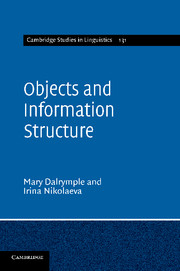Book contents
- Frontmatter
- Contents
- Preface and Acknowledgements
- List of Abbreviations
- 1 Introduction
- 2 Syntactic assumptions
- 3 Information structure in grammar
- 4 Syntax and information structure
- 5 Topicality and grammatical marking
- 6 Topical marking of nonsubjects
- 7 Topicality and DOM
- 8 Primary and secondary objecthood and DOM
- 9 Multiple objects and grammatical alignment
- 10 Semantic features, topicality and grammaticalisation
- 11 Conclusion
- References
- Author Index
- Language Index
- Subject Index
2 - Syntactic assumptions
Published online by Cambridge University Press: 05 October 2012
- Frontmatter
- Contents
- Preface and Acknowledgements
- List of Abbreviations
- 1 Introduction
- 2 Syntactic assumptions
- 3 Information structure in grammar
- 4 Syntax and information structure
- 5 Topicality and grammatical marking
- 6 Topical marking of nonsubjects
- 7 Topicality and DOM
- 8 Primary and secondary objecthood and DOM
- 9 Multiple objects and grammatical alignment
- 10 Semantic features, topicality and grammaticalisation
- 11 Conclusion
- References
- Author Index
- Language Index
- Subject Index
Summary
Nontransformational, constraint-based theories of grammar such as Construction Grammar (Croft 2001, Goldberg 2006), HPSG (Sag et al. 2003), Role and Reference Grammar (Van Valin 2003), Simpler Syntax (Culicover and Jackendoff 2005), and Lexical Functional Grammar (Bresnan 2001, Dalrymple 2001, Falk 2001) represent different aspects of the structure of an utterance as separate but related grammatical modules. Such theories assume that syntactic structure is related to semantics, information structure, and other linguistic levels not by means of transformational operations, but by constraints involving one or more levels of structure. Information-structure roles may be associated with particular phrase structural positions, but these positions do not define the roles (as they often do in tree-based, transformational theories such as Principles and Parameters Theory or Minimalism: Chomsky and Lasnik 1993, Chomsky 1995). Instead, the relations between grammatical, semantic, and information structural roles are specified in terms of constraints involving different levels of linguistic representation.
In LFG, these different aspects of linguistic information are represented by structures that may be of different formal types. The phrasal structure of the sentence is represented by a phrase structure tree, the constituent structure or c-structure. Grammatical functions like subject and object are represented by the functional structure or f-structure. Information structure (Choi 1999, Butt and King 1996, 2000) is related to other grammatical levels within the projection architecture of LFG (Kaplan 1987, Asudeh 2006).
- Type
- Chapter
- Information
- Objects and Information Structure , pp. 22 - 44Publisher: Cambridge University PressPrint publication year: 2011



